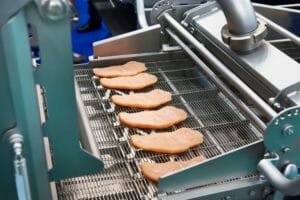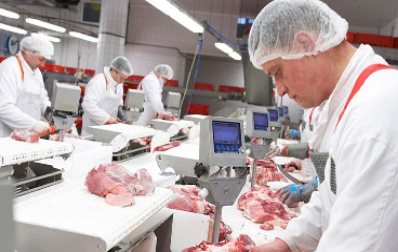Food safety in the meat and poultry industry is regularly subjected to intense regulation and scrutiny, all for good reason. Both food and especially employee safety in meat and poultry plants are being questioned now more than ever due to how easily contamination can occur and illnesses can spread. Processing animals risk both re-contamination and cross contamination due to multi-step evisceration and product processing. Additionally, employees often work in very close quarters, increasing the risk to employee health and safety. Implementing established and thorough sanitation measures with proper training will help keep the meat, meat products, and employees safe.
Keeping Meat Processing Clean
Meat and poultry sanitation largely focus on the decontamination of meat during the evisceration process when risk of contamination is highest. Microorganisms usually exist on heavily colonized areas of the animal, such as the skin, hide, feathers, gastrointestinal tract, or rectum. Knives, hooks, saws, and other equipment need to be sanitized with hot water during the slaughter process to prevent contamination of the carcass. The type and number of microbes depends on both the animal and the environment. Because there is such a vast field of potential harmful microorganisms that can contaminate meat, the animal, environment, and employees must comply with strict protocols. Risk of contamination diminishes as the product moves from raw materials to processing and manufacturing, but it is vital to ensure complete sanitation in the initial stages of production.

Avoiding Contamination
The sanitation process of meat and poultry plants is usually an entire working shift after a 16-20 hour workday. This third shift at the end of the day is the most important step in keeping the plant running. It begins with turning off and locking all equipment to ensure no one is injured during cleaning. All floors, walls, machines, equipment, utensils, and tools receive a hot water washdown to remove visible debris. Next, all surfaces are treated with a foam cleaning agent, scrubbed if necessary, and sprayed again with hot water of at least 180° to sufficiently reduce microbe and bacteria presence. SuperKlean’s steam & cold water or hot & cold water mixing stations achieve the same hot water temperature every time so employees can ensure consistent and complete plant sanitation during the washdown process.
Employee Safety
To ensure sanitation is upheld throughout the day, employees must be diligent in sanitizing tools and surfaces after use, changing gear when necessary, and upholding safety training. Human interaction and employee handling can result in cross contamination, so workers should be equipped with adequate PPE that can be regularly changed if needed. PPE also promotes worker safety, and because of the close proximity to others, plant employees should wear face shields, masks, and gloves to further prevent spreading contamination to the product or other employees. Meat and poultry plants are subject to frequent and thorough testing, and inspectors from the U.S. Department of Agriculture Food Safety Inspection Service can halt production if plant and equipment sanitation standards are not met. SuperKlean is a dedicated advocate for food and employee safety through proper training with the right sanitation equipment. SuperKlean mixing stations, industrial nozzles, and hot water hoses are the best and safest washdown equipment in the industry. SuperKlean face shields and face masks not only help your employees stay safe against workplace health threats, but also provide an extra layer of protection against cross contamination. You work hard to maintain meat and poultry sanitation, let SuperKlean do the hard work for you!


